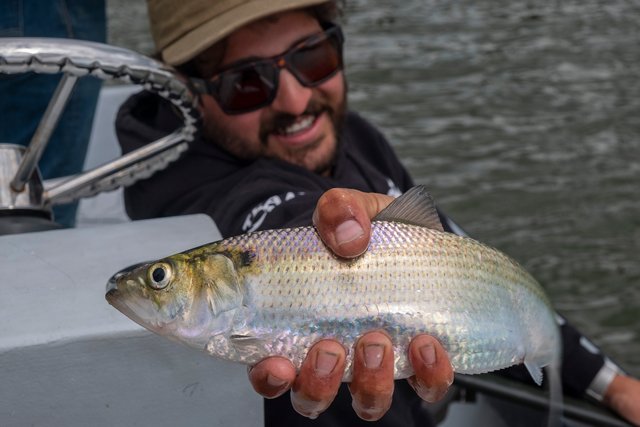We pick up speed with a backward lurch, skimming over the James River in a fiberglass motorboat, and I clutch my hat quickly to stop it blowing off my head as we pull away from Ancarrow’s Landing. I am on my way to investigate Richmond’s notorious “shad run” and will try my hand at fly-fishing.
Spotting the unmistakable form of a bald eagle against the dark ripples of the river, I watch the colossal bird rise into clear air, the silver flanks of a large fish flashing in its talons.
“Come spring, the ecosystem on this river totally wakes up,” says Reid Parker as he eyes the bird and its lunch. He’s a lifelong fisherman and Richmond resident who is part owner of Current Culture Fly and Coffee Shop, a soon-to-open fly-fishing outfitters and cafe near Westover Hills, who also guides fly-fishing tours throughout Virginia.
Richmond’s swath of the James, specifically from the 14th Street bridge down to the easternmost developments of Rocketts Landing, is a hot spot for anglers. Throughout the year, shad, gizzard, largemouth bass, smallmouth bass, striped bass and various species of catfish can all be caught in view of the Richmond skyline.
“If you know, you know,” quips Simón Valencia from the boat’s helm. Valencia is another seasoned fisherman and has recently transitioned from a career in social work to establish Current Culture with Parker.
People fishing crowd the northern and southern riverbanks in astonishing numbers, and I remark to Valencia that the Ancarrow’s Landing parking lot was almost overflowing with vehicles and people preparing to fish, many clutching multiple rods.
“This is nothing!” Valencia yells over the thrum of the boat’s engine as we spool under I-95 and find ourselves among over a dozen other boats vying for prime fishing position. “On the big days, people are lined up shoulder to shoulder all along those banks,” he says.
We are in the very heart of the shad run.
So elemental is this event, Virginia’s state tree, the dogwood, has hooks in it. “When the dogwood blossom is the size of a silver dollar, the shad are running,” Parker says. “They sometimes call it the shad tree.”
Shad, a species of herring, are a hard-fighting fish that provide thrilling game for anglers each spring when they leave their saltwater homes (“run”) to mate and spawn in freshwater rivers. In Virginia, only the Potomac rivals the James for shad season, but according to my guides, the James offers fewer crowds and easier access.
Valencia outfits me with a sturdy entry-level fly rod and seems far more confident than I am about my prospect of bagging a catch. I decide to trust his optimism.
“Pick up the phone, now hang up the phone,” he instructs me, referring to a motion of smoothly directing the rod and line upward and downward.
A conventional spinning reel setup relies on the bait’s weight to drive the line outward from a cast. A fly rod uses the motion of the line to build momentum for the cast, which allows much smaller bait to be used — exactly the type needed for shad fishing.
After some practice, I can feel the brightly colored fly-fishing line begin to build force, whipping around me in a cursive loop, suspended in the air with thrilling weightlessness. I sling the rod decisively forward, and the green grub-like “fly” lands with a minor plop in the water some 15 feet away.
“Don’t strip now; let it sink. OK, now strip! Strip the line!” Valencia is a keen teacher, and I begin “stripping” the line, tugging it by hand back toward me, the fly at the very end of the monofilament performing an enticing dance with every hand motion — or so I imagine.
Shad are not in the James to eat, they’re here to procreate. To get them near a hook, we pick a fight, sending small, brightly colored baits into the water that the shad might mistake for a predator hunting its eggs.
“Fish on!” Parker yells, his rod tip arching into the water and bent almost double. With deft movements he pulls in line while positioning himself for the upcoming fight. He allows the fish to take line briefly before reeling in, repeating this process multiple times, but always taking in more line than he lets out.
Now I can see it, curled in a muscular crescent just beneath the surface. Suddenly, the fish breaches the water in a thrash of churning green, and Parker dances with the creature once more, letting it run again before finally wresting it alongside the boat, quelled. Valencia cheers as he scoops it into a big net.
The shad is far more handsome than its unadorned name has led me to believe.
Rainbow iridescence runs along the top of its back, and it is a brawny fish, silver and corpulent between its gills and tail. Valencia points out an especially swollen belly — this is a female, heavily pregnant with coveted shad roe. Parker hefts his fish for a photo before deftly slipping his prize back into the James’ darkness.
Did I catch anything? Let’s just say I didn’t embarrass myself as a first-timer, with the occupants of the boat as a whole faring well. My foray into fly-fishing proved far less daunting than anticipated, and I’m proud of my firsthand exposure to the intricacies and effort it requires. As far as the shad and their annual run up to the falls of the James, start paying attention to the size of dogwood flowers, because this is a fantastic hidden dimension of Richmond life well worth experiencing.
Never miss a Sunday Story: Sign up for the newsletter, and we’ll drop a fresh read into your inbox at the start of each week. To keep up with the latest posts, search for the hashtag #SundayStory on Twitter and Facebook.
Credit: Source link































